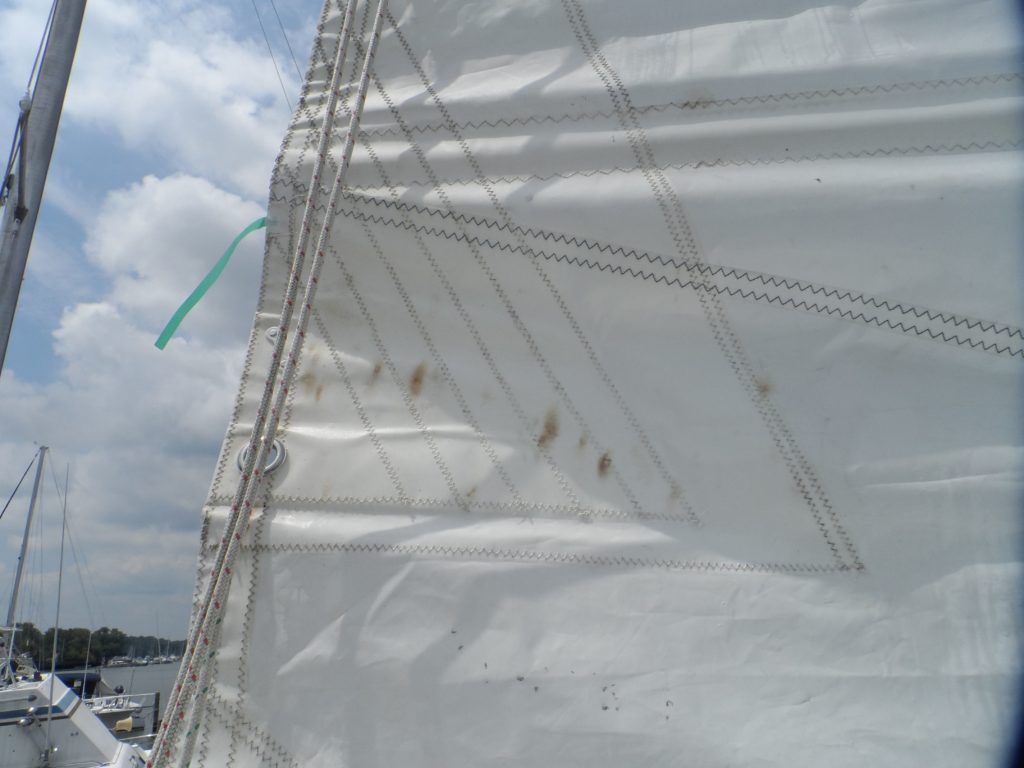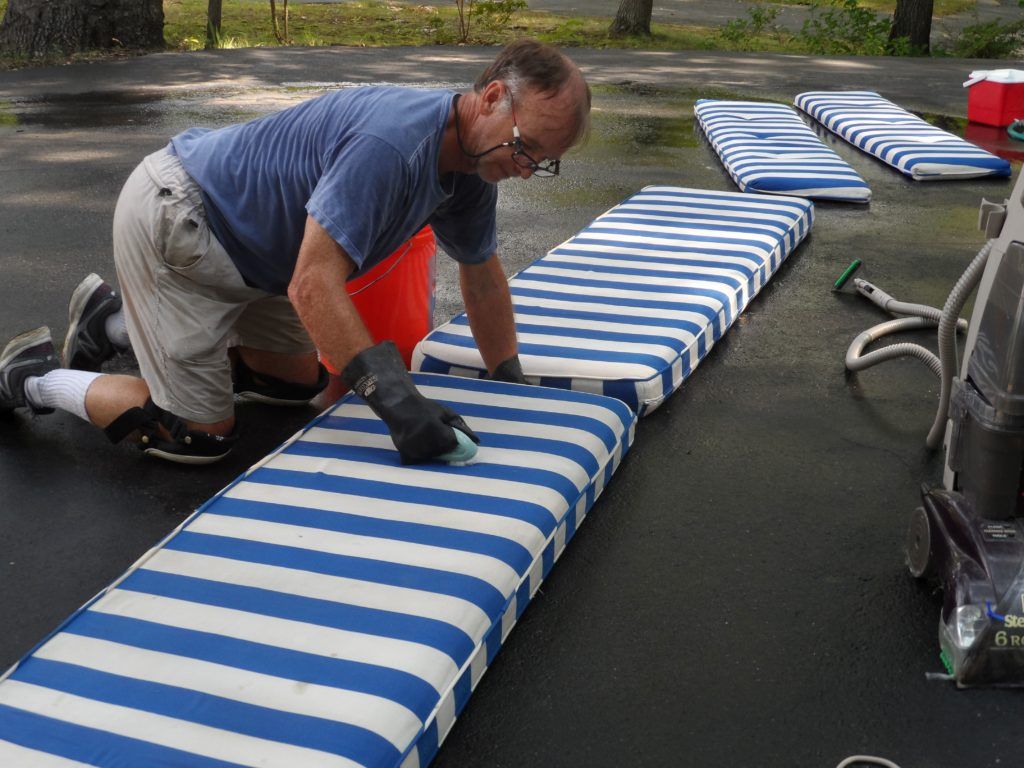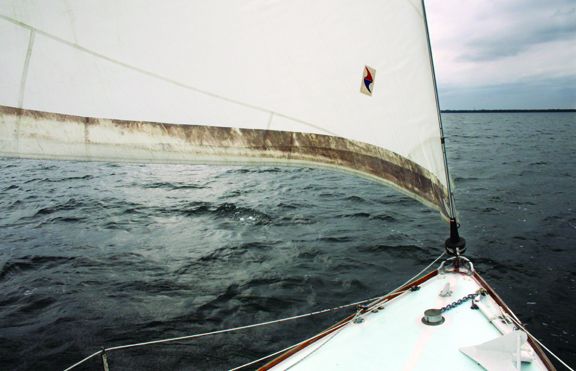If you’ve been looking for Practical Sailor‘s guidance on sail-cleaning, this blog post is a good place to start.
We published a PS Advisor on the topic of cleaning sails in the April 2002 issue, but our more recent research updates and adds to many of those findings. More recently, we carried out a test of five popular cleaners used for sail stain removal. This comprehensive report focused on achieving the ideal pH level for the type of stain, and comparing various cleaning products and methods.
Here’s a quick summary of that 2016 report, but it hardly covers all we have available on this topic. For more details, I encourage you to refer to the links in this post.
Of course, you could drop your sail off at your local sailmaker and, for a fee, they’ll do a good job. However, you can clean most stains yourself. Just be sure to set aside enough time. You also will need a large work area, and ideally, some way to soak the sail, or portions of it. We’ve found an inflatable baby pool works pretty well, but so will a dinghy full of clean water.
Be aware that some sailcloth materials (Kevlar and nylon in particular) are sensitive to certain substances—chlorine bleach and acetone, to name those most damaging. While Dacron holds up to mild doses of bleach, spinnakers and light-air sails made of nylon are particularly vulnerable. If you expose Kevlar or nylon to bleach—say you decide to rinse the sails in an ordinary swimming pool (which we sometimes do with our Dacron sails)—they can lose up to 90 percent of their original strength.
For washing your sails, most sailmakers recommend using mild soap and water, and avoiding anything abrasive. Use a soft brush, if necessary, to loosen dirt. For dirt or stains that are more deeply embedded, you may need to soak the sail, so you’ll have to locate some kind of large container, depending upon the size of the soiled area. (This is the time to requisition your kids’ inflatable swimming pool.) Avoid cleaners that contain biodegradable organic components that may become mildew food—most liquid laundry detergents have this failing, and actually encourage mildew regrowth.

For spot cleaning of rust stains, a 20:1 solution of Multi-use CLR (or a similar formula) seemed to be the most effective in our testing. CLR is one of the essentials recommended for our cost-effective one-bucket cleaning kit. Dilute 20:1 with freshwater, soak for up to 15 minutes, and rinse. For extra measure, you could buy pH strips (at pet or pool stores) to monitor the pH, particularly with nylon.
The trick is to reduce the pH far enough to dissolve the metal oxide without damaging the cloth. Nylon is vulnerable to strong acids, literally dissolving before your eyes in battery acid, so nothing with a pH of less than 3 should be used. Polyester and other fabrics are less vulnerable, but we like to keep the pH above 3 because nylon thread can always sneak in.
Mildew is a more common enemy. Although some sailmakers advise a diluting a 5.25-percent solution of sodium hypochlorite, this always comes with capital letter cautions like this one from North Sails’ advice on cleaning mildew stains: “DO NOT use BLEACH on KEVLAR or NYLON, EVER, UNDER ANY CIRCUMSTANCES! We have seen people poke their fingers easily through spinnakers rinsed in chlorine-treated swimming pools.”
Our own recommendation is to use an oxygen bleach such as Oxiclean, which also works well with rope. These types of bleaches generate an uncharged radical that can permeate through the film faster than the larger hypochlorous or borate ions found in other types of bleach. Also, these oxygen bleaches are less aggressive to the fabric than the other types.
After spot cleaning and soaking, be sure to rinse thoroughly and allow to dry in the sun. Often it is this last bit—exposure to sun—that does the final whitening. It seems that the oxygen bleach weakens enough bonds that a half-day in the sun can often finish the job to perfection. They need drying time anyway, and the sun will safely finish your work.
Our overall cleaning/protecting champ is tech editor Drew Frye’s do-it-yourself, super cheap Formula B. This is was one of two DIY formulas featured in our article “Homemade Mildew Preventers that Really Work.” These mildew cleaners/preventatives, which cost just pennies per ounce, really do work, not just on sails. We’ve used them regularly (every 3 months) on the hull, deck, and cushions of our dry-stored Catalina 22, and are astounded by how effective they have been.

Formula B
1 quart hot water
2 tablespoons baking soda
2 tablespoons Borax
1 tablespoon TSP Cleaner (trisodium phosphate)
Although spot cleaning is effective on stubborn stains, pre-soaking is the key. As with an laundry project, soaking in warm water (~105-degrees, hot-tub temperature), makes cleaning easier. It is always better to soak for longer rather than to use stronger chemicals, since the cloth is not affected by long soaking times at a safe pH, but the stain will slowly vanish. The solution will lose its effectiveness after 3-8 hours.
If you prefer an off-the-shelf mildew cleaner for spot treatment, Starbrite’s Canvas and Sail Cleaner performed well in our test. We had mixed results with various mildew removers on sails in our 2009 test of mildew removers. Many of these contain bleach in higher concentrations, so check the label for concentration. Frankly, we found none of these to perform noticeably better than Formula B when we allowed the sail to soak.
When you’ve finished cleaning, always rinse the sail liberally with fresh water. And, if you hang your sails to dry, do so at a time when it’s not windy. If a sail is left to flog or flutter, you can do more harm than good. Remember, sails are composed of fibers, and the more back and forth bending those fibers have to endure, the more quickly they’ll lose their strength.
Because stains vary, there is non one-size-fits-all solution. For rust stains, we liked CLR. Dilute 20:1 with freshwater, soak for up to 15 minutes, and rinse. For extra measure, you could buy pH strips (at pet or pool stores) to monitor the pH, particularly with nylon.
For surface dirt on polyester sails and canvas, we like Formula B; it kills mildew and leaves an inhibiting residue. For mildew and algae stains we like all of the oxygen bleach products (such as Oxiclean). The formula CS-530 may have a slight edge in soil removal, but frugal sailors will want to save this for a last-ditch attempt.
You’ll find additional information about the care and cleaning of sails on the North Sails website. Almost any large sail loft with a service department as most have arrangements with specialty cleaning services. If you are in the market for new sails — or want to review our full library of sail maintenance and repair articles in one location, our 3-volume Ebook “A Look at Sails,” covers this topic from almost every angle. And if you’ve got more than just sails to clean, our three-volume eBook Marine Cleaners, is your guide to removing and repelling everything from waterline grime to rust stains to bird droppings.

































